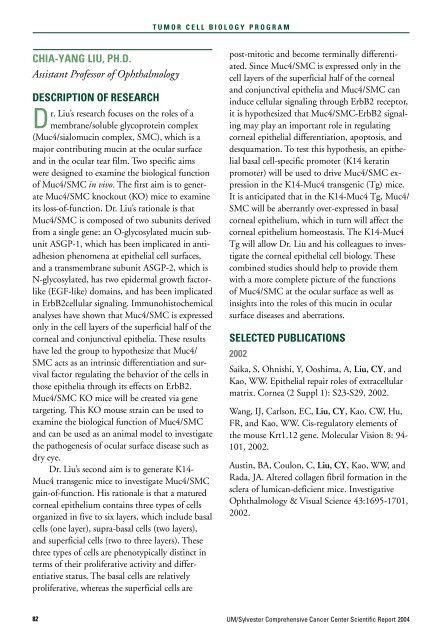SCIENTIFIC REPORT 2004 - Sylvester Comprehensive Cancer Center
SCIENTIFIC REPORT 2004 - Sylvester Comprehensive Cancer Center
SCIENTIFIC REPORT 2004 - Sylvester Comprehensive Cancer Center
You also want an ePaper? Increase the reach of your titles
YUMPU automatically turns print PDFs into web optimized ePapers that Google loves.
T U M O R C E L L B I O L O G Y P R O G R A M<br />
CHIA-YANG LIU, PH.D.<br />
Assistant Professor of Ophthalmology<br />
DESCRIPTION OF RESEARCH<br />
Dr. Liu’s research focuses on the roles of a<br />
membrane/soluble glycoprotein complex<br />
(Muc4/sialomucin complex, SMC), which is a<br />
major contributing mucin at the ocular surface<br />
and in the ocular tear film. Two specific aims<br />
were designed to examine the biological function<br />
of Muc4/SMC in vivo. The first aim is to generate<br />
Muc4/SMC knockout (KO) mice to examine<br />
its loss-of-function. Dr. Liu’s rationale is that<br />
Muc4/SMC is composed of two subunits derived<br />
from a single gene: an O-glycosylated mucin subunit<br />
ASGP-1, which has been implicated in antiadhesion<br />
phenomena at epithelial cell surfaces,<br />
and a transmembrane subunit ASGP-2, which is<br />
N-glycosylated, has two epidermal growth factorlike<br />
(EGF-like) domains, and has been implicated<br />
in ErbB2cellular signaling. Immunohistochemical<br />
analyses have shown that Muc4/SMC is expressed<br />
only in the cell layers of the superficial half of the<br />
corneal and conjunctival epithelia. These results<br />
have led the group to hypothesize that Muc4/<br />
SMC acts as an intrinsic differentiation and survival<br />
factor regulating the behavior of the cells in<br />
those epithelia through its effects on ErbB2.<br />
Muc4/SMC KO mice will be created via gene<br />
targeting. This KO mouse strain can be used to<br />
examine the biological function of Muc4/SMC<br />
and can be used as an animal model to investigate<br />
the pathogenesis of ocular surface disease such as<br />
dry eye.<br />
Dr. Liu’s second aim is to generate K14-<br />
Muc4 transgenic mice to investigate Muc4/SMC<br />
gain-of-function. His rationale is that a matured<br />
corneal epithelium contains three types of cells<br />
organized in five to six layers, which include basal<br />
cells (one layer), supra-basal cells (two layers),<br />
and superficial cells (two to three layers). These<br />
three types of cells are phenotypically distinct in<br />
terms of their proliferative activity and differentiative<br />
status. The basal cells are relatively<br />
proliferative, whereas the superficial cells are<br />
post-mitotic and become terminally differentiated.<br />
Since Muc4/SMC is expressed only in the<br />
cell layers of the superficial half of the corneal<br />
and conjunctival epithelia and Muc4/SMC can<br />
induce cellular signaling through ErbB2 receptor,<br />
it is hypothesized that Muc4/SMC-ErbB2 signaling<br />
may play an important role in regulating<br />
corneal epithelial differentiation, apoptosis, and<br />
desquamation. To test this hypothesis, an epithelial<br />
basal cell-specific promoter (K14 keratin<br />
promoter) will be used to drive Muc4/SMC expression<br />
in the K14-Muc4 transgenic (Tg) mice.<br />
It is anticipated that in the K14-Muc4 Tg, Muc4/<br />
SMC will be aberrantly over-expressed in basal<br />
corneal epithelium, which in turn will affect the<br />
corneal epithelium homeostasis. The K14-Muc4<br />
Tg will allow Dr. Liu and his colleagues to investigate<br />
the corneal epithelial cell biology. These<br />
combined studies should help to provide them<br />
with a more complete picture of the functions<br />
of Muc4/SMC at the ocular surface as well as<br />
insights into the roles of this mucin in ocular<br />
surface diseases and aberrations.<br />
SELECTED PUBLICATIONS<br />
2002<br />
Saika, S, Ohnishi, Y, Ooshima, A, Liu, CY, and<br />
Kao, WW. Epithelial repair roles of extracellular<br />
matrix. Cornea (2 Suppl 1): S23-S29, 2002.<br />
Wang, IJ, Carlson, EC, Liu, CY, Kao, CW, Hu,<br />
FR, and Kao, WW. Cis-regulatory elements of<br />
the mouse Krt1.12 gene. Molecular Vision 8: 94-<br />
101, 2002.<br />
Austin, BA, Coulon, C, Liu, CY, Kao, WW, and<br />
Rada, JA. Altered collagen fibril formation in the<br />
sclera of lumican-deficient mice. Investigative<br />
Ophthalmology & Visual Science 43:1695-1701,<br />
2002.<br />
82<br />
UM/<strong>Sylvester</strong> <strong>Comprehensive</strong> <strong>Cancer</strong> <strong>Center</strong> Scientific Report <strong>2004</strong>
















